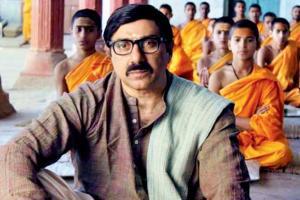What does Chandraprakash Dwivedi's film Mohalla Assi (releasing Nov 16) compel you to do? Read Kashinath Singh's Kaashi Ka Assi

Sunny Deol in a still from Mohalla Assi
 An unpardonable sin for an Indian adult (and I mention this as advice for younger ones who can still help it) is to not be able to casually speed-read at least two languages. Almost every Indian can fluently speak, minimum, two languages, anyway.
An unpardonable sin for an Indian adult (and I mention this as advice for younger ones who can still help it) is to not be able to casually speed-read at least two languages. Almost every Indian can fluently speak, minimum, two languages, anyway.
This might seem normal to us. It is considered an achievement in most parts of the world. My spoken Hindi, for instance, is as good as any heartland bloke's. Written Hindi though, having dropped the language from formal curriculum Std VIII onwards, is abysmally slow - to the point that the eyes travel word for word, rather than the brain seamlessly absorbing thoughts and long sentences.
ADVERTISEMENT
This immediately sucks the pleasures from reading, of any kind. Which is why, like several highly recommended Hindi titles in the past, I gave up on Kashinath Singh's Kaashi Ka Assi, despite having picked up the novel with much excitement, since the recommender, actor Saurabh Shukla, had totally primed me for its acerbic wit and generous world view, a couple of years ago.
Although in a relatively minor role of a Brahmin selling his wares on a ghat in Banaras, Shukla had then recently shot for Mohalla Assi, based on the 2004 political/cultural satire, and directed by Dr Chandraprakash Dwidevi (best known as television's Chanakya).
The film's title refers to the mohalla in and around Assi - the 80th, and southernmost - ghat on Ganga, in Varanasi, which itself derives its name from the confluence of rivers Varuna and Asi, where the city of 23,000 temples originally came up. Now, Varanasi, or Banaras, as an image/idea, might well be the most desi cliché ever - unsurprisingly, often curated for the western eye. This is a reason one was instantly struck by Neeraj Ghaywan's film Masaan (2015). For, it neatly edited out the touristy, exotic aspects of Banaras, to reveal the lived-in experience of a proper Indian small-town like any other, naturally placed in the heart of bigotry and darkness.
Mohalla Assi, the film (like, presumably, the novel), is set between the late '80s, and early '90s, with North India passing through a tornado-like political churn over 'Mandir', 'Mandal', and the market (economy). It simultaneously touches upon the impact of all three on the common folk on the street, or a specific riverbank, if you may.
Is Assi, as a setting, diametrically opposite to the burning pyres of Harishchandra Ghat in Masaan? Geographically, yes. It's over a 20-minute walk on the same stretch, dotted by embassy-like structures founded by pre-Independence kings and zamindars, neither of whom exist anymore.
Assi and Harishchandra are, of course, still both in Old Banaras, walking through congested lanes of which - traversing regular homes, shops, lodges, between temples - feels like hopping around a pulsating museum anyway.
Nestled in a relatively quiet corner though, with a huge front-yard facing the river, Assi is definitely the more happening ghat, with Korean restaurant, fine pizzeria, attracting a bulk of both tourists, and seekers of mystical truths, immensely benefitting the local economy held together by seers, and a series of thugs.
That apart, everyone in these parts is a 'gyaani'. Unsurprisingly they always address each other as, "Guru." The local chai shop is the closest approximation to the Lok Sabha, where democracy in its heated, daily political debates, plays out among interlocutors of all hues - between rank communalists, and die-hard commies - indulging in "chai (and newspaper) pe charcha," as it were.
That might be true for most of the argumentative, eastern India. But Banaras - in its peculiar twang and takia-kalam ("Samjhe ki nahi?"), groups regularly breaking into the chant, "Har Har Mahadev," (even movie screenings, by the way), inevitably followed by, "Bh*****ke", as an endearment; both being the "rashtra bhasha" (national language) of Assi - feels inevitably unique still.
The mohalla is simultaneously stuck and travelling in time. How does one capture this distinctiveness without descending into caricatures? Dwivedi's film (which releases on November 16), in that sense, while undoubtedly authentic, seems uncomfortably over-the-top. Is it possible to overlook this, and like it still?
Only if you can, somehow or the other, seep into the subtext, and find within the movie a powerful piece of contemporary literature - absolutely majestic in its sweep, taking within it aspects so central to Banaras, specifically Assi, but also the rest of India: Expounding on the relationship between caste and commerce, spirituality and market, politics and religion. Delving into liberalism, that's so inherent to a Hindu culture/society. Looking at the primacy of English, and subsequent irrelevance of non-business languages…
This looks like an incredibly faithful adaptation from literary fiction. Which isn't necessarily a good thing for a film. Here's what it can still do, though. Yes, I have re-started reading Kashinath Singh's Kaashi Ka Assi, and intend to soldier on, for sure!
Mayank Shekhar attempts to make sense of mass culture. He tweets @mayankw14 Send your feedback to mailbag@mid-day.com
Catch up on all the latest Mumbai news, crime news, current affairs, and also a complete guide on Mumbai from food to things to do and events across the city here. Also download the new mid-day Android and iOS apps to get latest updates
 Subscribe today by clicking the link and stay updated with the latest news!" Click here!
Subscribe today by clicking the link and stay updated with the latest news!" Click here!







